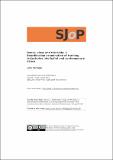Dance, class and the body: a Bourdieusian examination of training trajectories into ballet and contemporary dance
View/
Date
13/06/2014Author
Metadata
Show full item recordAltmetrics Handle Statistics
Altmetrics DOI Statistics
Abstract
This article is a result of a small-scale interview-based study that explored the social conditions of ballet and contemporary dance production in the city of Glasgow. This study draws on interviews given by twelve professional dancers and choreographers, both freelancers and company based, who for the purposes of this research offered to share their experiences of studying and making dance. More specifically, this article aspires to map the social conditions of possibility of dancing and making dance, drawing on the class condition and career trajectories of those individuals who became dancers. With the aid of Bourdieu’s (1984; 1990; 1993a) concepts of ‘capitals’ (economic, social, cultural and physical), ‘habitus’ and ‘trajectories’, this piece of work will discuss how class conditions give or limit access to vocational training as a career pathway to dance. It is argued that, although the social origin of this sample presents relative variety, dance is an activity that demands different types of support, which are eventually more accessible to those social groups with more assets.
Citation
Tsitsou, L. (2014). Dance, class and the body: a Bourdieusian examination of training trajectories into ballet and contemporary dance. Scottish Journal of Performance, 1(2), pp. 63–89.
Publication
Scottish Journal of Performance
ISSN
2054-1961Type
Journal article
Rights
This work is licensed under a Creative Commons Attribution 4.0 International License.
http://creativecommons.org/licenses/by/4.0/
Collections
Except where otherwise noted within the work, this item's licence for re-use is described as This work is licensed under a Creative Commons Attribution 4.0 International License.
Items in the St Andrews Research Repository are protected by copyright, with all rights reserved, unless otherwise indicated.


